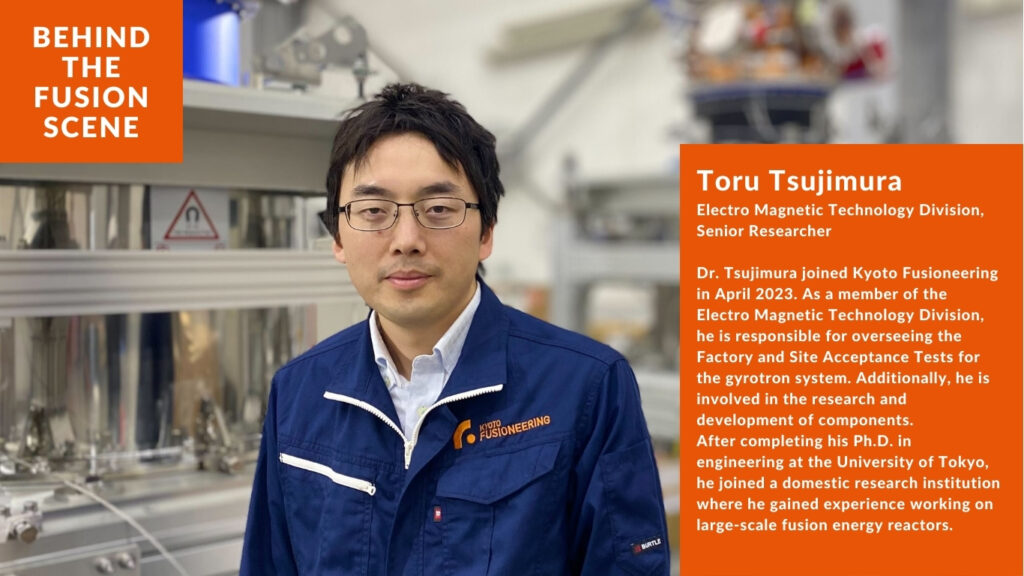
In a nutshell:
Dr. Tsujimura is an engineer deeply involved in the research and development of gyrotron systems. From his early days fueled by a passion for fusion energy and engineering, he dived into the industry and began contributing to the research and development of large-scale fusion reactors at a national research institution in Japan. In pursuit of seeking new challenges, he joined Kyoto Fusioneering (KF) in 2023 and is currently playing a key role at the forefront of gyrotron development, one of the company’s core projects.
What are your responsibilities at Kyoto Fusioneering (KF)?
As a member of the Electro Magnetic Technology Team, I am involved in the development and manufacturing of gyrotron systems used for plasma heating. I especially focus on activities such as Factory Acceptance Tests (FAT) and Site Acceptance Tests (SAT) to verify the specifications of the equipment. Recently, we successfully completed tests to stabilise the output of two gyrotrons for the UK Atomic Energy Authority (UKAEA) in 2021. Currently, at our research and development hub, the Kyoto Research Centre, I am conducting tests involving the integration of gyrotrons with other components with other team members.
Achieving the requested performance in gyrotron system manufacturing is no easy task. It involves meticulous adjustments and long-term processes such as aging to stabilise operations until all requirements, including output and duration. Honestly, it can be challenging when the expected results do not come easily, but the sense of accomplishment when we achieve the desired outcomes is substantial.
Additionally, I am involved in the research and development of devices necessary to assemble gyrotrons into a system. For example, I worked on the development of a device that absorbs microwaves, called a “dummy load,” as an alternative to plasma. (Further on the role of dummy loads is detailed in our company blog)
Due to limited manufacturers, creating a large dummy load is pricy, and it needs compatibility with each gyrotron output and frequency. Therefore, after joining KF in April 2023, I was asked to develop a large-scale dummy load. Fortunately, I had some knowledge and information but confirming its accuracy and gathering additional data made the journey quite challenging. I felt relieved when we managed to complete the design and manufacturing within about three months, and it functioned as intended during the FAT.

When did you become interested in fusion energy?
I first learnt about fusion energy when I was in junior high school. My father had a book on the theory of relativity, and reading it sparked my interest. Although the content was too complicated to understand for me at the time, I understood the concept of fusion energy. Also, the movie “Back to the Future” was another trigger. Fusion energy is featured in Part 2 of the film, where it is used as fuel for the DeLorean, a car that can travel to the future. Around the same time, my interest in science and technology was getting bigger and bigger. So, after graduating from junior high school, I enrolled in a technical high school specialising in electrical engineering. While the impending energy crisis was approaching, I learnt that the potential realisation of fusion energy could be the ultimate energy solution.
Around that time, the international project ITER, aimed at creating an experimental fusion reactor, had started. Learning about the significant efforts towards achieving fusion energy realisation, my long-held fascination with fusion energy was reignited. I became convinced that fusion energy was on the verge of becoming a reality and decided that I wanted to contribute to its development.
Building on the knowledge gained in technical school, I transferred to the University of Tokyo to specialise in fusion energy. In the research lab, I studied the mechanism of creating plasma known as high-beta confinement using an experimental device that merges plasma, called magnetic reconnection. Though for a short period, I also had the opportunity to conduct research at the Princeton Plasma Physics Laboratory in the US. Being able to research alongside outstanding international scientists and students was a stimulating and valuable experience during my student days.
While I fulfilled my dream of researching fusion energy, I gradually felt the burning desire to work with larger devices handling plasma. Fortunately, after completing my Ph.D. at the university, I was able to join the National Institute for Fusion Science (NIFS). Here, I worked on enhancing the performance of the Electron Cyclotron Heating (ECH) system using gyrotrons in the Large Helical Device (LHD), one of several forms of fusion energy reactors. Since I had always wanted to research large-scale devices, it was hugely rewarding.
It was during this time that I became deeply involved with gyrotrons. As magnetic confinement of LHD does not require plasma current, it allows for stable plasma maintenance, making it convenient for ECH research. I engaged in various research activities, such as controlling plasma heating systems based on calculations of high-temperature plasma, wave propagation, and absorption, as well as developing transmission system components. I loved NIFS’s atmosphere where there were lively discussions and exposure to various perspectives.
Why did you decide to transition to KF?
While my research at NIFS was fulfilling, after the completion of the LHD project in 2022, I felt the urge to explore new challenges. Additionally, while NIFS had its strengths as an academic research institution, I had always harboured a desire to work as a fusion engineer and contribute to realising fusion reactors. During my daily research on the fusion energy industry, I happened to come across recruitment notices from KF for a position related to gyrotrons.
Upon exploring the website, I resonated deeply with the business overview of KF, which highlighted the global deployment of gyrotrons harnessing Japan’s technological prowess. Moreover, the team supporting this business, including our CTO, Prof. Sakamoto, had practical experience with gyrotrons at research institutions and manufacturers, which relieved me. Although I had a few concerns about jumping to a startup, I remember applying right away.
The driving force behind this decision was that I found that I have about 30 years left to contribute to the dream of early fusion energy realisation. Therefore, the prospect of KF expanding gyrotron systems crucial for future fusion reactors globally and accelerating the development of fusion energy worldwide appealed to me. Moreover, I saw KF as an ideal place to leverage my experience in plasma heating research and development.
Additionally, in 2017, I experienced a debilitating illness that made my body not function as I want. I faced months of struggles with the pain of things once taken for granted becoming difficult and the fear that my dreams might come to an end. With intense rehabilitation and the dedicated support of my family, I fully recovered, but during that time, I realised the unpredictability of life and the importance of pursuing challenges and dreams. Consequently, I found excitement in working for a startup where challenges are embraced.
What are your impressions of working at KF?
I have found the experience to be as expected. I am working on the research and development of gyrotron systems alongside experienced team members, and it is indeed fulfilling. Interacting with legends in the gyrotron community whose names I heard during my student days exposes me to their knowledge and expertise, making the work with them stimulating.
Certainly, there are daily challenges, but with the support of the team, I feel I am overcoming obstacles and growing personally. In this regard, I can confidently say that KF is a company recommended for everyone, from young professionals to those with a strong desire for growth. The company encourages everyone to contribute wholeheartedly to the realisation and industrialisation of fusion energy, creating additional value through collaboration within the team and with other research institutions.
In the gyrotron team, face-to-face communication is important, and it is recommended to join on an in-office day once a week, and we meet in person at the test site. In this environment, each team member freely expresses their opinions and challenges each other while striving to achieve success in the research and development of gyrotron systems. Thanks to this, we successfully developed a low-frequency gyrotron system with challenging beam handling characteristics.
Furthermore, looking at the business team as an example, they secure gyrotron system contracts from around the world, including the US, Europe, and Asia. To meet these demands, our gyrotron team puts in maximum effort, and business members are deeply involved in discussions. Seeing our products deployed worldwide fills me with joy that could not be achieved by an individual engineer alone.
At KF, everyone is dedicated to realising and industrialising fusion energy. For myself, I continue to consider how I can contribute more to the fusion energy industry and to a sustainable and prosperous society. While remaining who I am, I look forward to pushing forward. During my active years, I hope to see the realisation of fusion energy, living in a world powered by that electricity.




